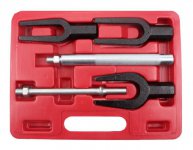Lifetime warranty is great - hope you never have to claim it though. Most require compliance with "reasonable use". It's very difficult to prove you were only leaning on it with your hand and not increasing leverage with a piece of pipe (or whatever). So (as with all forms of insurance?) it depends on the attitude of the warranty provider, which in turn probably is influenced by how much profit margin there is in the product and how important "image" is to that brand. A big name, with expensive product - Snap on, Facom, Britool (maybe), you get the idea - will find it very important for people to equate the name with quality and reliability. Better not name brands I wouldn't buy!Just found out, that my flare nut spanner set comes with LIFE time warranty, and over 1880 of them have been sold, not just 1000. I think everyday 10s of them seem being sold :hm:
So if any of it breaks, then maybe they will replace with a new set?:idea:

You are using an out of date browser. It may not display this or other websites correctly.
You should upgrade or use an alternative browser.
You should upgrade or use an alternative browser.
General Tools for DIY Panda
- Thread starter Theleman
- Start date
Currently reading:
General Tools for DIY Panda
scottpanda
New member
- Joined
- Feb 21, 2019
- Messages
- 5
- Points
- 0
after using my facom 18v impact wrench at work for the last 6 months. ive bought the dewalt equivalent to use at home. The torque these produce is incredible, i haven't really used air at all since buying the facom gun.
Dewalt dcf899hn for anyone that's interested.
The time that these can save is enough for me to invest in. although pricey they imo are well worth the cost and i get trade price so are bit cheaper.
ive always believed in buying the best i can afford and always go for lifetime guarantee. i use predominately snap on at work (because the van comes weekly and can replace any breakages) and halfords at home, again because i get halfords trade which puts them at a good price.

Dewalt dcf899hn for anyone that's interested.
The time that these can save is enough for me to invest in. although pricey they imo are well worth the cost and i get trade price so are bit cheaper.
ive always believed in buying the best i can afford and always go for lifetime guarantee. i use predominately snap on at work (because the van comes weekly and can replace any breakages) and halfords at home, again because i get halfords trade which puts them at a good price.

Last edited:
after using my facom 18v impact wrench at work for the last 6 months. ive bought the dewalt equivalent to use at home. The torque these produce is incredible, i haven't really used air at all since buying the facom gun.[/IMG]
Being now retired I work on my "hobbies" at home. I have a 3hp 90 litre compressor and a couple of air impact guns. The compressor goes from empty to full in around 5 to 10 minutes (never timed it) and is quite quiet (belt driven) so doesn't annoy neighbours. The guns themselves though are quite noisy! I'd been thinking about an electric rattle gun but wonder about charge? I have a number of 18v power tools, drill, circular saw, jig saw, electric screwdriver etc which are not used daily. So invariably they are flat when I want to use them. I see this as a very real annoyance with them and I suppose the Impact gun would be the same? Thought I'd found the answer in the Clarke CEW 1000 which is mains powered but it is on/off. No variable trigger. So I think I'll just have to go on being a very occasional annoyance to my neighbours?
scottpanda
New member
- Joined
- Feb 21, 2019
- Messages
- 5
- Points
- 0
at work i have 2 5ah batteries and find them great ,when one is in use the other is on charge , and 1hr charge time. i find the lithium batteries hold their charge when not in use, the old ni cad bats were terrible for losing charge.
- Joined
- Sep 14, 2009
- Messages
- 19,492
- Points
- 3,294
My DeWalt 18V XR drill (the brushless type) has three 1.3AH batteries. They sound small but charge quickly so you just swap them around as needed. The big benefit is a tool that's less heavy to lift. The same 1.3AH will work with any of the XR range.
Bigger batts can be fitted but I have not found the need even on some quite heavy duty DIY jobs.
This is the less powerful impact wrench
https://www.ebay.co.uk/itm/DEWALT-18V-XR-Compact-Impact-Wrench-DCF880N-Brand-New-In-Box-Pick-Up-Lei/223463577804?epid=1407591019&hash=item34077798cc:g:eIgAAOSwS4Vb9pWe
This is the high torque wrench but it's a lot heavier and how often would it be needed?
https://www.ebay.co.uk/itm/Dewalt-18v-DCF899N-XR-High-Torque-Impact-Wrench-Li-Ion-1-2-Bare-Unit-Rp-DCF889/311319869357?hash=item487c1c37ad&enc=AQADAAADEFjVrDbVsZ8oH%2F8PNHtt9VX4%2Fw7FZcmMuqsX8uaFEduVh2vQd08PsOBn99O0jcz4MP%2B7HfwCUbyFV6wSw%2FpFlsTIfN05HtQhUd1%2BCjFiID%2BVtWPFYtp8EJ47FyqmQEGsH8UZsq8xARQmJa9ilk0lQsyO77FpdNeAJwQO2Lw1WD1sITITGI4u%2Fv6AXSmcrBqoG35d4T2gpoL5A547S7iQCKWBi56pEma%2FefWeQKWzYT9wAM5pj3a1emQaXnuxu6y2RZlzbhLQ2%2BkGgC7MfLpPtwKm3HsnZN8gzxNCMvXazQ%2Ffl2F4ROa6bX9LrLAAjEvAoS%2BnlnlOM%2BEUmjJzoOA7S8lxx8JTput32N4IVnXhv%2BLFc8CTtd6ilun011iBBJ4g%2F3iwouMZF6dKsi0gIsP9vgFhjCco%2FFyuOGrn0BDVg4gtpCHxnbPpj0F8ujN2J9hX3NQ4i%2BHJGc7Rgo60VbfU6OpFGcULH1GDYzcl3xxet7YYjLCwVUYSwMj2VLbJjneuxwi%2FKLJmIGO2mH1K7lJXsGpj1JqowrwXsOiyyCmW07ciClb45hS6%2FgGU42FhOFu8GOgrE2z%2BBuV%2FYOzIxMkvzCILLXL16KeKD0wXXqI2D8gG8N8rkjwvcvhAQSpc8UcjQ4R2s%2F70Jg3q8UwtiFvwYM4O36OSGnxtcoJHjwx81OXGLuNxwF%2FaWQ3UvB%2BcA6v1VkRWSx35s1%2B%2BL6%2BhfgEDkghpdut29BO1hnJ21hixyXLKYpT48N2N%2BBJ%2FD31rfUrwKKz9VO9BVt%2F1zhWsgG4gn3mRByUoLsIjqbYsEkt8A53jGRKpBbsjmq6Z4piGRiQDlblwYjb9et1StiLQGXz3IywIbn3N0iJe%2B2WyKxpaQsPLkva0raYLPjW5%2BaUR%2FosnYOydzIcV6dF1rc%2Bvc2DL%2B%2B54TQ4B9Z%2FyujC%2BdX1DgiDmHvoWs%2BfCuvGMPkBnDGZCz6%2FlQbgmLmNxTStEHTPWCmew4jRRi7egKKGfDIB96VPj9p501j%2F2ae06ArfQ2ld%2BYu5QdCX9aUF1jvLNRgBIKsE%3D&checksum=311319869357968d997e276f4fd29500103a231c4a74
This drill has two 2AH batteries
https://www.ebay.co.uk/itm/DeWalt-DCD778D2T-GB-18V-2-0Ah-Li-Ion-XR-Brushless-Drill-2-x-Batteries/123715840840?hash=item1cce09eb48:g:WMUAAOSw~2Bcn4pO
Bigger batts can be fitted but I have not found the need even on some quite heavy duty DIY jobs.
This is the less powerful impact wrench
https://www.ebay.co.uk/itm/DEWALT-18V-XR-Compact-Impact-Wrench-DCF880N-Brand-New-In-Box-Pick-Up-Lei/223463577804?epid=1407591019&hash=item34077798cc:g:eIgAAOSwS4Vb9pWe
This is the high torque wrench but it's a lot heavier and how often would it be needed?
https://www.ebay.co.uk/itm/Dewalt-18v-DCF899N-XR-High-Torque-Impact-Wrench-Li-Ion-1-2-Bare-Unit-Rp-DCF889/311319869357?hash=item487c1c37ad&enc=AQADAAADEFjVrDbVsZ8oH%2F8PNHtt9VX4%2Fw7FZcmMuqsX8uaFEduVh2vQd08PsOBn99O0jcz4MP%2B7HfwCUbyFV6wSw%2FpFlsTIfN05HtQhUd1%2BCjFiID%2BVtWPFYtp8EJ47FyqmQEGsH8UZsq8xARQmJa9ilk0lQsyO77FpdNeAJwQO2Lw1WD1sITITGI4u%2Fv6AXSmcrBqoG35d4T2gpoL5A547S7iQCKWBi56pEma%2FefWeQKWzYT9wAM5pj3a1emQaXnuxu6y2RZlzbhLQ2%2BkGgC7MfLpPtwKm3HsnZN8gzxNCMvXazQ%2Ffl2F4ROa6bX9LrLAAjEvAoS%2BnlnlOM%2BEUmjJzoOA7S8lxx8JTput32N4IVnXhv%2BLFc8CTtd6ilun011iBBJ4g%2F3iwouMZF6dKsi0gIsP9vgFhjCco%2FFyuOGrn0BDVg4gtpCHxnbPpj0F8ujN2J9hX3NQ4i%2BHJGc7Rgo60VbfU6OpFGcULH1GDYzcl3xxet7YYjLCwVUYSwMj2VLbJjneuxwi%2FKLJmIGO2mH1K7lJXsGpj1JqowrwXsOiyyCmW07ciClb45hS6%2FgGU42FhOFu8GOgrE2z%2BBuV%2FYOzIxMkvzCILLXL16KeKD0wXXqI2D8gG8N8rkjwvcvhAQSpc8UcjQ4R2s%2F70Jg3q8UwtiFvwYM4O36OSGnxtcoJHjwx81OXGLuNxwF%2FaWQ3UvB%2BcA6v1VkRWSx35s1%2B%2BL6%2BhfgEDkghpdut29BO1hnJ21hixyXLKYpT48N2N%2BBJ%2FD31rfUrwKKz9VO9BVt%2F1zhWsgG4gn3mRByUoLsIjqbYsEkt8A53jGRKpBbsjmq6Z4piGRiQDlblwYjb9et1StiLQGXz3IywIbn3N0iJe%2B2WyKxpaQsPLkva0raYLPjW5%2BaUR%2FosnYOydzIcV6dF1rc%2Bvc2DL%2B%2B54TQ4B9Z%2FyujC%2BdX1DgiDmHvoWs%2BfCuvGMPkBnDGZCz6%2FlQbgmLmNxTStEHTPWCmew4jRRi7egKKGfDIB96VPj9p501j%2F2ae06ArfQ2ld%2BYu5QdCX9aUF1jvLNRgBIKsE%3D&checksum=311319869357968d997e276f4fd29500103a231c4a74
This drill has two 2AH batteries
https://www.ebay.co.uk/itm/DeWalt-DCD778D2T-GB-18V-2-0Ah-Li-Ion-XR-Brushless-Drill-2-x-Batteries/123715840840?hash=item1cce09eb48:g:WMUAAOSw~2Bcn4pO
Last edited:
This post contains affiliate links which may earn a commission at no additional cost to you.
scottpanda
New member
- Joined
- Feb 21, 2019
- Messages
- 5
- Points
- 0
whilst i agree the dcf899 is heavy it is capable of doing any thing i ask of it with the 3 settings feature. the smaller impact is really just a nut runner rated at 203nm whilst that may seem capable would struggle with wheel nuts of modest torque. To overcome the static torque plus corrosion etc ample more torque has to be applied to initiate movement for example a lug nut tightened to 110nm would need substantially more than 110nm to get it moving. as apposed to dynamic torque that is applied during motion that would be less.
for hub nuts etc it would not stand a chance but the dcf899 does them with ease also strut top nuts,axle bolts etc etc.
having used the facom gun in a professional setting for the last 6 months it has never failed to remove a fastener.
for hub nuts etc it would not stand a chance but the dcf899 does them with ease also strut top nuts,axle bolts etc etc.
having used the facom gun in a professional setting for the last 6 months it has never failed to remove a fastener.
- Joined
- Sep 14, 2009
- Messages
- 19,492
- Points
- 3,294
Heavy tools are great when you need the power but get tiresome for the 90% of the time when you don't.
For professional use I'd have a big heavy (£160 plus battery) extended gearbox impact wrench with a lighter weight version for "normal" fasteners and nut running. Two sets of sockets as well to keep them both set up and ready. An 18V power drill and socket adapters does a great job for nut running. I use mine for most jobs including wheel bolts and follow up with ordinary socket or torque wrench as appropriate.
They wont take massive torque but they are only used for nut running with the screwdriver setting at max so my wrist isn't taken out when the threads hit bottom.
https://www.ebay.co.uk/itm/Driver-Spanner-Power-Drill-Nut-Socket-Bit-Adapter-Hex-Shank-Hex-Wrench-Sleeve/264226701724?hash=item3d8523819c:g:yPQAAOSw8-lcf05x
For professional use I'd have a big heavy (£160 plus battery) extended gearbox impact wrench with a lighter weight version for "normal" fasteners and nut running. Two sets of sockets as well to keep them both set up and ready. An 18V power drill and socket adapters does a great job for nut running. I use mine for most jobs including wheel bolts and follow up with ordinary socket or torque wrench as appropriate.
They wont take massive torque but they are only used for nut running with the screwdriver setting at max so my wrist isn't taken out when the threads hit bottom.
https://www.ebay.co.uk/itm/Driver-Spanner-Power-Drill-Nut-Socket-Bit-Adapter-Hex-Shank-Hex-Wrench-Sleeve/264226701724?hash=item3d8523819c:g:yPQAAOSw8-lcf05x
This post contains affiliate links which may earn a commission at no additional cost to you.
I've only very recently become aware of a whole family of tools I never knew existed. In the workshop we had a couple of air impact chisels which were mostly used for chopping up recalcitrant exhaust systems! Working at home I never, until recently, had a compressor that could drive one so never bought one.
About a week ago I picked up on a you tube video (American) showing an air hammer being used in a completely different, non destructive way, with an adaptor which had a square end to accept a socket. Just above the socket was a hexagon which allows a spanner to be used to rotate the punch to and fro. In use (this demo was on a seized caliper bleed nipple) the socket is applied to the nipple - but could be a bolt just as easily - Then the hammer is triggered shocking the whole area around the nipple. After a few moments the spanner is used to loosen the nipple. I really like this idea. There seem to be kits of punches available for working on other corroded/seized fixings - for example track rod end locking nuts, taper ball joints, etc.
You tube "Pheonix systems brake free" to see more if you want. I can't find anyone over here selling the Pheonix brand, may have to get my sister to bring one over with her this summer (note to self - make sure it fits european guns) There's a very nice Hazet set 9035 VH which I fancy but it's quite expensive. I've seen stuff on ebay too. Lots of research to do methinks.
By the way, I don't know how to do those links (which come up showing web sites in blue) which you can click on to see what someone is recommending. Anyone like to enlighten me?
About a week ago I picked up on a you tube video (American) showing an air hammer being used in a completely different, non destructive way, with an adaptor which had a square end to accept a socket. Just above the socket was a hexagon which allows a spanner to be used to rotate the punch to and fro. In use (this demo was on a seized caliper bleed nipple) the socket is applied to the nipple - but could be a bolt just as easily - Then the hammer is triggered shocking the whole area around the nipple. After a few moments the spanner is used to loosen the nipple. I really like this idea. There seem to be kits of punches available for working on other corroded/seized fixings - for example track rod end locking nuts, taper ball joints, etc.
You tube "Pheonix systems brake free" to see more if you want. I can't find anyone over here selling the Pheonix brand, may have to get my sister to bring one over with her this summer (note to self - make sure it fits european guns) There's a very nice Hazet set 9035 VH which I fancy but it's quite expensive. I've seen stuff on ebay too. Lots of research to do methinks.
By the way, I don't know how to do those links (which come up showing web sites in blue) which you can click on to see what someone is recommending. Anyone like to enlighten me?
Just found a better one on you tube at www.youtube.com/watch?v=RMVV51gyoPU.
I can see lots of situations where this might work. For instance, when you've cut the pipe off a tube nut and are now using a socket to loosen the nut. Substitute one of the hammer type punches and use it on a ball joint when you've done the splitter up as tight as you dare and it's still not moving. How about using a square ended chisel on clevis type bottom ball joints where after you've taken the clevis pin out it still won't move due to rust. I just keep on thinking of more.
I just gotta have one! Oh, and I noticed that when I typed in the whole address, including the www. it turned blue after I submitted the post and became active. I also must try cut and paste (don't do that often so don't know if it works?) - or do I need to type the whole thing in each time? - oh dear, me and computers*?*?
I can see lots of situations where this might work. For instance, when you've cut the pipe off a tube nut and are now using a socket to loosen the nut. Substitute one of the hammer type punches and use it on a ball joint when you've done the splitter up as tight as you dare and it's still not moving. How about using a square ended chisel on clevis type bottom ball joints where after you've taken the clevis pin out it still won't move due to rust. I just keep on thinking of more.
I just gotta have one! Oh, and I noticed that when I typed in the whole address, including the www. it turned blue after I submitted the post and became active. I also must try cut and paste (don't do that often so don't know if it works?) - or do I need to type the whole thing in each time? - oh dear, me and computers*?*?
Last edited:
- Joined
- Sep 14, 2009
- Messages
- 19,492
- Points
- 3,294
I replaced a motorbike brake bleed nipple with stainless. No more corrosion. Oh Yes!!
Wrong! The aluminium caliper corroded far more badly and siezed he thing. I got it out by sparking up some arc weld onto the bled nipple. The sudden fierce but focussed heat shifted the seizure. New OEM bleed nipple with some anti seize paste and all was well again.
Ive used an SDS hammer drill on chisel more for setting rivets. It works really well so Jock's special air tool will probably work for him if he ever needs to set solid rivets.
Wrong! The aluminium caliper corroded far more badly and siezed he thing. I got it out by sparking up some arc weld onto the bled nipple. The sudden fierce but focussed heat shifted the seizure. New OEM bleed nipple with some anti seize paste and all was well again.
Ive used an SDS hammer drill on chisel more for setting rivets. It works really well so Jock's special air tool will probably work for him if he ever needs to set solid rivets.
Now I've got an SDS drill and a set of those hex adapter bits which let you fit 1/4, 3/8 and 1/2 sockets. Of course you're right, if I set it to "rotation stop" I could get the same effect. Must give it a try some time. Only thing is it's a muckle great unwieldy beast of a thing and getting any feel for what you are doing on something small, like a bleed nipple (especially the wee ones they use on cylinders) could be nigh on impossible. You could break it easily I fear. Still, I've probably got some old bits and pieces I could have a go on. Obtaining the rotation with the spanner could be difficult though.
PS. Solid rivets? I actually remember riveting new linings to brake shoes when I first started. In fact I remember it quite well. We must have done it quite a lot! Now you've got me thinking. I'm sure I saw the riveting punch in the same drawer as my split rings which we discussed earlier in this thread. I'm off to have a look and I'll post a picture if I find it.
PS. Solid rivets? I actually remember riveting new linings to brake shoes when I first started. In fact I remember it quite well. We must have done it quite a lot! Now you've got me thinking. I'm sure I saw the riveting punch in the same drawer as my split rings which we discussed earlier in this thread. I'm off to have a look and I'll post a picture if I find it.
Last edited:
- Joined
- Sep 14, 2009
- Messages
- 19,492
- Points
- 3,294
My SDS drill is a Bosch & not much bigger than a typical corded power drill. but it's a lot more bulky than any air powered tool.
I'd not want to use it on brake nipples. But a socket that fits over the nipple to impact around it could vibrate around the thread rather than directly onto it.
How about these?
https://www.ebay.co.uk/itm/SDS-Plus-Hex-Socket-Adapter-Square-Drill-Bit-Holder-Extension-BI1017/153387735085?epid=4023277687&hash=item23b69f182d:g:ivUAAOSwc0lcbY~u
But SDS hammers into the hole while rotating. Fine for drilling (or chiselling with rotation stopped) but it wont shock loosen a seized bolt anything like as well as an impact wrench which has a rotary hammer action.
I'd not want to use it on brake nipples. But a socket that fits over the nipple to impact around it could vibrate around the thread rather than directly onto it.
How about these?
https://www.ebay.co.uk/itm/SDS-Plus-Hex-Socket-Adapter-Square-Drill-Bit-Holder-Extension-BI1017/153387735085?epid=4023277687&hash=item23b69f182d:g:ivUAAOSwc0lcbY~u
But SDS hammers into the hole while rotating. Fine for drilling (or chiselling with rotation stopped) but it wont shock loosen a seized bolt anything like as well as an impact wrench which has a rotary hammer action.
Last edited:
This post contains affiliate links which may earn a commission at no additional cost to you.
Yup, knew it was there somewhere. Not in the brake tools drawer though it was in with the punches - logical I suppose? Anyway here it is in all it's glory:
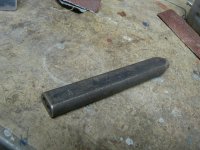
And now, for the younger members among us, before modern adhesives were developed the linings on brake shoes were all riveted on. Here's a spare I bought at an autojumble many years ago for my Daf. For those in the "know" yes it's the same as a mini!
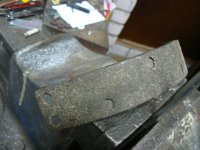
You can clearly see the rivet heads.
If we now look at the business end you will see there is a "hole" and a dome shaped punch:
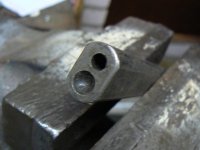
The rivet would be inserted from the lining side and the "hole" positioned over the shank which was now projecting out of the rear of the shoe. The entire shoe/lining/rivet assembly was then positioned over a plain punch held in a vice so that the head of the rivet was supported on the punch held in the vice. the "hole" in the punch was then placed over the shaft of the rivet sticking out through the shoe and a couple of light taps with a hammer would seat the lining and it's rivet nicely against the shoe. Holding everything steady the punch would then be repositioned with the domed end over the rivet and a few sharp taps with a hammer would form the rivet (often made of copper) into a domed head thus securing the lining in place. Then it would be on to the next one (10 on a Mini shoe but, as you can see here, the lining manufacturers would often miss out every second of the middle rivets so you ended up actually doing 7).
Here's a pic of how it would look in operation:
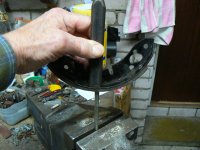
I used to have another design which was for use with hollow rivets. Instead of a domed punch it had a "peaked" design which spread the end rather than rounding it. It's obviously found a much better place to hide!
I was just reflecting on how it is that I can remember, in great detail, all about the punches, how to use them and where they might be in my toolbox (must be well over 30 years since I relined a set of shoes) and yet I can go to the top of our staircase and find myself standing there wondering what or why I came up here!

And now, for the younger members among us, before modern adhesives were developed the linings on brake shoes were all riveted on. Here's a spare I bought at an autojumble many years ago for my Daf. For those in the "know" yes it's the same as a mini!

You can clearly see the rivet heads.
If we now look at the business end you will see there is a "hole" and a dome shaped punch:

The rivet would be inserted from the lining side and the "hole" positioned over the shank which was now projecting out of the rear of the shoe. The entire shoe/lining/rivet assembly was then positioned over a plain punch held in a vice so that the head of the rivet was supported on the punch held in the vice. the "hole" in the punch was then placed over the shaft of the rivet sticking out through the shoe and a couple of light taps with a hammer would seat the lining and it's rivet nicely against the shoe. Holding everything steady the punch would then be repositioned with the domed end over the rivet and a few sharp taps with a hammer would form the rivet (often made of copper) into a domed head thus securing the lining in place. Then it would be on to the next one (10 on a Mini shoe but, as you can see here, the lining manufacturers would often miss out every second of the middle rivets so you ended up actually doing 7).
Here's a pic of how it would look in operation:

I used to have another design which was for use with hollow rivets. Instead of a domed punch it had a "peaked" design which spread the end rather than rounding it. It's obviously found a much better place to hide!
I was just reflecting on how it is that I can remember, in great detail, all about the punches, how to use them and where they might be in my toolbox (must be well over 30 years since I relined a set of shoes) and yet I can go to the top of our staircase and find myself standing there wondering what or why I came up here!
My SDS drill is a Bosch & not much bigger than a typical corded power drill. but it's a lot more bulky than any air powered tool.
I'd not want to use it on brake nipples. But a socket that fits over the nipple to impact around it could vibrate around the thread rather than directly onto it.
How about these?
https://www.ebay.co.uk/itm/SDS-Plus-Hex-Socket-Adapter-Square-Drill-Bit-Holder-Extension-BI1017/153387735085?epid=4023277687&hash=item23b69f182d:g:ivUAAOSwc0lcbY~u
But SDS hammers into the hole while rotating. Fine for drilling (or chiselling with rotation stopped) but it wont shock loosen a seized bolt anything like as well as an impact wrench which has a rotary hammer action.
Mrs Jock is watching a dire program about some woman who collects stuff from council tips and, after altering,reconditioning,painting and generally titivating them sells them on to people with too much money for "silly" prices. It's annoying me so much I decided to go and try using the SDS as suggested above.
I bought this drill to do building projects. It was used extensively when we took my boy's first flat back to bare walls. Then there was the garage project with driveway gates at my daughter's in Salisbury, and others. It was a Lidl (or was it Aldi, maybe?) cheapie and I thought it might do less than half of what it has. Still going well but it's a heavy old beast! Here it is compared to my trusty old Black and Decker (which is also, surprisingly, still going strong - just a set of brushes a chuck and a strip and regrease in all the years I've had it:
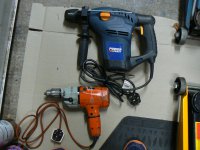
I haven't used it (the SDS) in about 18 months and as soon as I took it out of it's case to photograph it I realized it just wasn't going to be suitable for the sort of thing (loosening bleed nipples etc) we're considering here. Made a good job of cleaning it after the last time I used it though didn't I? A rag dampened with WD40 puts a lovely finish on things like this if you know you're not going to be using it again for a wee while.
Dave. If you look at that second post with the link, you'll see he's using a deep socket and I think the shock is being applied exactly as you say - to the casting rather than the nipple itself - and I totally agree that this is how you would want to do it. What I really like about using the air hammer with this adaptor is that the hammer is only hammering, unlike with an impact wrench (rattle gun) there is no power rotation being applied by the tool. This leaves it up to you as to how much rotational force you are manually, via the spanner, applying to the fixing. This leaves you in charge of how hard to lean on the spanner and also the "feel feedback" of whet's going on at the business end. I just think this could really work rather well?
This post contains affiliate links which may earn a commission at no additional cost to you.
- Joined
- Sep 14, 2009
- Messages
- 19,492
- Points
- 3,294
I would not want to risk a power tool on a bleed nipple. But the impacts with a socket on the caliper around the nipple could be enough to shock loosen it.
If you do get it out fir the new one with some antiseize grease on the threads.
Your SDS does look a bit of an animal. Clearly OTT for jobs like this as is mine TBH.
If you do get it out fir the new one with some antiseize grease on the threads.
Your SDS does look a bit of an animal. Clearly OTT for jobs like this as is mine TBH.
Your SDS does look a bit of an animal. Clearly OTT for jobs like this as is mine TBH.
Yes it can be. You have to be very wary when drilling deep holes and clear the drilling debris frequently by running the drill in and out of the hole. If it locks up in the hole the only safe thing to do is let go of it or it'll likely break bones!
My impact wrench is by Siliverline and was around £40. Still haven't used for working on car. But I can see it could be used for sharpening my vintage hand push lawnmower with a socket racheting on the bolt off the gear.
I managed to get hold of another breaker bar = 1/2" one but 60cm long with some sockets and extension bit. I am gonna put it in the boot of the car in case having to take off tyres.
We have noise pollution from every direction in the back garden from the neighbors gardens. I think one or two of them seem to run workshops. Every morning there are noise of electric router going or table saw. And then I could hear someone cutting grass with petrol mower, and then cutting hedges. Always something is going on over the back garden. And I also make noise with petrol grass trimmer, petrol hedge cutter and Bosch drills, and I also use power hose washing slabs and drives and windows.
Across the front garden, we have main road. So have lots of cars passing making noise, so we are not well situated in noise pollution, but have been here for now 10 years, and pretty got used to the environments
I was contemplating getting an Air Compressor, but then decided not to. I think my worry was space in the shed, and also expense of having to buy new wrenches and drills and other tools which go with it. And I read about it that they can get fairly noisy causing possible annoyance to the neighbors.
But I could see it would be real good tool to have especially for even cleaning tools and shed floors. Now I use petrol garden blower to clean shed floor, which is working OK, but it is also very noisy and ineffective in cleaning tools such as lawnmowers.
I was looking at CV joint working tools and also balljoint splitting tools on ebay. They were about tenner each, but wasn't sure would be useful in practice. Maybe I will get them when and if I get to work on the stuff.
I managed to get hold of another breaker bar = 1/2" one but 60cm long with some sockets and extension bit. I am gonna put it in the boot of the car in case having to take off tyres.
We have noise pollution from every direction in the back garden from the neighbors gardens. I think one or two of them seem to run workshops. Every morning there are noise of electric router going or table saw. And then I could hear someone cutting grass with petrol mower, and then cutting hedges. Always something is going on over the back garden. And I also make noise with petrol grass trimmer, petrol hedge cutter and Bosch drills, and I also use power hose washing slabs and drives and windows.
Across the front garden, we have main road. So have lots of cars passing making noise, so we are not well situated in noise pollution, but have been here for now 10 years, and pretty got used to the environments
I was contemplating getting an Air Compressor, but then decided not to. I think my worry was space in the shed, and also expense of having to buy new wrenches and drills and other tools which go with it. And I read about it that they can get fairly noisy causing possible annoyance to the neighbors.
But I could see it would be real good tool to have especially for even cleaning tools and shed floors. Now I use petrol garden blower to clean shed floor, which is working OK, but it is also very noisy and ineffective in cleaning tools such as lawnmowers.
I was looking at CV joint working tools and also balljoint splitting tools on ebay. They were about tenner each, but wasn't sure would be useful in practice. Maybe I will get them when and if I get to work on the stuff.
- Joined
- Sep 14, 2009
- Messages
- 19,492
- Points
- 3,294
A good scissor type ball joint separator is always handy but apart from that, just get stuff when you need it.
The 600mm breaker bar is a very useful tool. Even when you don't need it's outright force, you can work more safely as not heaving so hard so less likely to slip and hurt yourself. When using 6 point sockets and cant get a line on the nut, turn the socket one flat on the drive handle and now you'll be able to get the nut and socket aligned.
I have one of these in the car. Extended to undo the wheel nuts, closed to tighten them.
https://www.ebay.co.uk/itm/Extendab...=1733582007267d1c2ac3a4cd4574b4f3e2375d590b89
The 600mm breaker bar is a very useful tool. Even when you don't need it's outright force, you can work more safely as not heaving so hard so less likely to slip and hurt yourself. When using 6 point sockets and cant get a line on the nut, turn the socket one flat on the drive handle and now you'll be able to get the nut and socket aligned.
I have one of these in the car. Extended to undo the wheel nuts, closed to tighten them.
https://www.ebay.co.uk/itm/Extendab...=1733582007267d1c2ac3a4cd4574b4f3e2375d590b89
This post contains affiliate links which may earn a commission at no additional cost to you.
A good scissor type ball joint separator is always handy but apart from that, just get stuff when you need it.
I have one of these in the car. Extended to undo the wheel nuts, closed to tighten them.
https://www.ebay.co.uk/itm/Extendab...=1733582007267d1c2ac3a4cd4574b4f3e2375d590b89
I think it's worth buying a good quality ball joint splitter if you are serious about continuing to work on cars - and still have a few good years left in your body!
Those expanding wheel braces work well. As you say, extend to undo and collapse to tighten (Tightening with it extended is inviting stripped threads or even a snapped stud) My oldest boy keeps one in his car and the only annoying thing about it is that, unlike a power bar, you can't straighten it and use it to spin the nuts off after slackening. I bought him a deep socket so that he can just take it off the brace once the nuts are slackened and, because it sticks out a fair bit you can then use it to spin them off by hand. Personally I keep an old rusty Halfords power bar in my boot.
This post contains affiliate links which may earn a commission at no additional cost to you.
I ordered this one for ball joint remover kit.
I wonder if it would work OK for the Panda cars.
For breaker bar, yes, I feel 60cm one very well balanced in my hand. I also have 75cm Sealey one, and it is great, but feel that it is more suitable for long reach places.
For carrying in the boot, 60cm seem just right. I also have a cross tyre wrench by Draper Read Label (for £9), which is to quickly turns bolts on tyres after loosening the bolts with breaker bar. Both of them in the car will do nicely I feel.
I wonder if it would work OK for the Panda cars.
For breaker bar, yes, I feel 60cm one very well balanced in my hand. I also have 75cm Sealey one, and it is great, but feel that it is more suitable for long reach places.
For carrying in the boot, 60cm seem just right. I also have a cross tyre wrench by Draper Read Label (for £9), which is to quickly turns bolts on tyres after loosening the bolts with breaker bar. Both of them in the car will do nicely I feel.
Attachments
Last edited:
Similar threads
- Replies
- 91
- Views
- 3K


